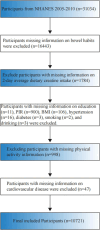Association of dietary creatine intake from meat protein sources with different types of intestinal problems: insights from NHANES 2005-2010
- PMID: 40786687
- PMCID: PMC12331507
- DOI: 10.3389/fnut.2025.1586569
Association of dietary creatine intake from meat protein sources with different types of intestinal problems: insights from NHANES 2005-2010
Abstract
Background: Given the growing interest in gut health, particularly in the context of irritable bowel syndrome (IBS), this study investigates the potential effects of dietary creatine intake on measures of gut health. Additionally, in response to anecdotal reports on the internet that have not been corroborated by clinical trials, this research examines the relationship between creatine consumption and gastrointestinal outcomes, aiming to address the existing knowledge gap in this area.
Methods: This study utilized data from the 2005-2010 National Health and Nutrition Examination Survey (NHANES). Multivariable logistic regression and subgroup analyses were conducted to examine the association between dietary creatine intake and the risk of diarrhea and constipation. Additionally, restricted cubic spline (RCS) analysis was employed to assess potential nonlinear relationships.
Results: In the fully adjusted model, each one-unit increase in the log-transformed 2-day average dietary creatine intake-equivalent to a tenfold increase in absolute intake-was associated with a 19% lower risk of chronic constipation (adjusted OR = 0.81, 95% CI: 0.65-0.96, p = 0.015). However, no significant association was found between dietary creatine intake and chronic diarrhea (adjusted OR = 1.04, 95% CI: 0.87-1.36, p = 0.421). The protective effect of higher dietary creatine intake against chronic constipation was more pronounced in males (adjusted OR = 0.77, 95% CI: 0.66-0.89, p < 0.001), younger individuals (adjusted OR = 0.89, 95% CI: 0.79 ∼ 0.99, p = 0.047)), and participants without cardiovascular disease (adjusted OR = 0.91, 95% CI: 0.83 ∼ 0.99, p = 0.047). RCS analysis confirmed a linear relationship between 2-day average dietary creatine intake and the risk of chronic constipation after adjusting for confounding variables.
Conclusion: Higher dietary creatine intake may offer protective benefits against chronic constipation, particularly in specific subgroups, while showing no significant association with chronic diarrhea. Further large-scale studies are warranted to clarify creatine's role in gastrointestinal health. These findings highlight the potential of creatine as a dietary factor in promoting gut health.
Keywords: NHANES; constipation; creatine; diarrhea; gut health; nutrition.
Copyright © 2025 Zheng, Huang, Wang, Du, Jiang, Xiao and Wang.
Conflict of interest statement
The authors declare that the research was conducted in the absence of any commercial or financial relationships that could be construed as a potential conflict of interest.
Figures






Similar articles
-
The relationship between flavonols intake and stroke in the elderly: a cross-sectional study from NHANES (2007-2010 and 2017-2018).J Stroke Cerebrovasc Dis. 2025 Aug;34(8):108373. doi: 10.1016/j.jstrokecerebrovasdis.2025.108373. Epub 2025 Jun 7. J Stroke Cerebrovasc Dis. 2025. PMID: 40490174
-
Dose-Dependent Effects of Dietary n-3 Fatty Acids on Bowel Health: Plant-Sourced ALA Modulates Diarrhea Risk While Marine-Sourced DHA/EPA Prevent Constipation in NHANES 2005-2010.Food Sci Nutr. 2025 Aug 6;13(8):e70769. doi: 10.1002/fsn3.70769. eCollection 2025 Aug. Food Sci Nutr. 2025. PMID: 40772019 Free PMC article.
-
Association Between Composite Dietary Antioxidant Index and Pregnancy: Insights from the NHANES.Reprod Sci. 2025 Jul;32(7):2362-2374. doi: 10.1007/s43032-025-01905-8. Epub 2025 Jun 23. Reprod Sci. 2025. PMID: 40550984
-
Nutritional interventions for survivors of childhood cancer.Cochrane Database Syst Rev. 2016 Aug 22;2016(8):CD009678. doi: 10.1002/14651858.CD009678.pub2. Cochrane Database Syst Rev. 2016. PMID: 27545902 Free PMC article.
-
Effects of a gluten-reduced or gluten-free diet for the primary prevention of cardiovascular disease.Cochrane Database Syst Rev. 2022 Feb 24;2(2):CD013556. doi: 10.1002/14651858.CD013556.pub2. Cochrane Database Syst Rev. 2022. PMID: 35199850 Free PMC article.
References
LinkOut - more resources
Full Text Sources
Miscellaneous

